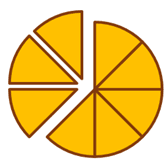Fraction Calculator
Addition: (a/b) + (c/d) = (ad + bc)/bd
Subtraction: (a/b) - (c/d) = (ad - bc)/bd
Multiplication: (a/b) × (c/d) = ac/bd
Division: (a/b) ÷ (c/d) = ad/bc
Example:
3/4 + 1/2 = (3×2 + 1×4)/(4×2) = 10/8 = 5/4
Mixed to Improper: a b/c = (a×c + b)/c
Then use fraction operation formulas
Example:
2 3/4 + 1 1/2 = 11/4 + 3/2 = 11/4 + 6/4 = 17/4 = 4 1/4
Find GCD of numerator and denominator
Divide both by GCD to simplify
Example:
15/25 → GCD is 5
15÷5 / 25÷5 = 3/5
Decimal to Fraction: Multiply by 10^n where n is decimal places
Fraction to Decimal: Divide numerator by denominator
Example:
1.375 = 1375/1000 = 11/8
5/8 = 0.625
Understanding Fractions in Math
A fraction is a mathematical way of showing a part of a whole.

It has two components: a numerator and a denominator.
The numerator (top number) tells how many parts you have.
The denominator (bottom number) shows the total number of equal parts the whole is divided into.
For example, in the fraction 3/8, the number 3 is the numerator and 8 is the denominator. Imagine a pie cut into 8 equal slices—if you eat 3 slices, you’ve eaten 3/8 of the pie. The part left would be 5/8. One key rule to remember: the denominator can never be zero, as dividing by zero is undefined in math.
Fractions can be added, subtracted, multiplied, divided, and simplified. Let’s explore how each operation works.
How to Add Fractions
Adding fractions is different from adding regular numbers because you need a common denominator. A common method is to multiply the numerators and denominators of the fractions by the product of their denominators.
Formula:
a/b + c/d = (a×d + b×c) / (b×d)
Example:
3/4 + 1/6
= (3×6 + 1×4) / (4×6)
= (18 + 4) / 24
= 22/24
= 11/12 (after simplification)
You can use this method for any number of fractions by multiplying each fraction’s numerator and denominator by the product of all other denominators.
Example:
1/4 + 1/6 + 1/2
= 12/48 + 8/48 + 24/48
= 44/48
= 11/12
Using Least Common Multiple (LCM)
A more efficient way to add fractions is by finding the LCM of the denominators. The LCM is the smallest number that all denominators divide into evenly.
For example:
LCM of 4, 6, and 2 is 12.
Now convert each fraction to have a denominator of 12:
1/4 = 3/12
1/6 = 2/12
1/2 = 6/12
Total = 3/12 + 2/12 + 6/12 = 11/12
How to Subtract Fractions
Subtracting fractions works just like addition—you still need a common denominator.
Formula:
a/b – c/d = (a×d – b×c) / (b×d)
Example:
3/4 – 1/6
= (3×6 – 1×4) / (4×6)
= (18 – 4) / 24
= 14/24
= 7/12 (simplified)
How to Multiply Fractions
Multiplying fractions is simple—you don’t need a common denominator.
Formula:
a/b × c/d = (a×c) / (b×d)
Example:
3/4 × 1/6 = 3/24 = 1/8
How to Divide Fractions
To divide fractions, multiply the first fraction by the reciprocal of the second (flip the second fraction).
Formula:
a/b ÷ c/d = a/b × d/c = (a×d) / (b×c)
Example:
3/4 ÷ 1/6
= 3/4 × 6/1
= 18/4
= 9/2
Simplifying Fractions
A simplified fraction has no common factors (other than 1) between the numerator and denominator. For example:
220/440 simplifies to 1/2
(divide both numbers by their GCF, which is 220)
The calculator simplifies automatically and can also convert to mixed numbers when needed.
Converting Fractions to Decimals
To change a decimal to a fraction, understand the place value.
Example:
0.1234 = 1234/10000
This simplifies to 617/5000 (dividing by 2)
To convert a fraction to a decimal, divide the numerator by the denominator.
Example:
1/2 = 0.5
5/100 = 0.05
Fractions with denominators like 10, 100, or 1000 are easier to convert.
